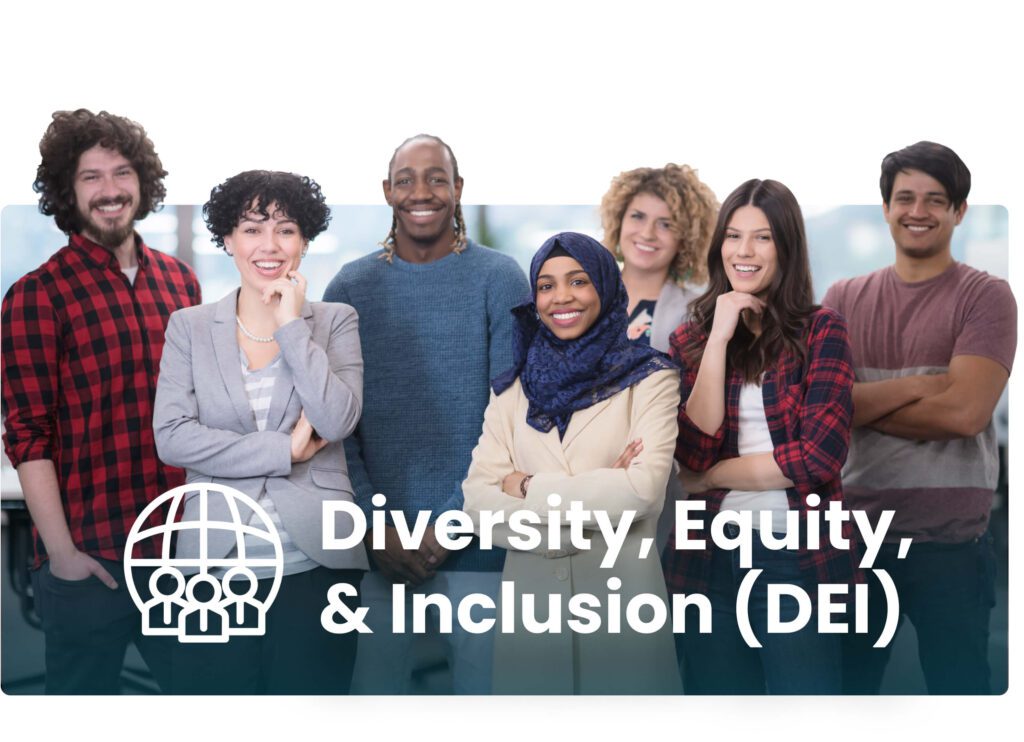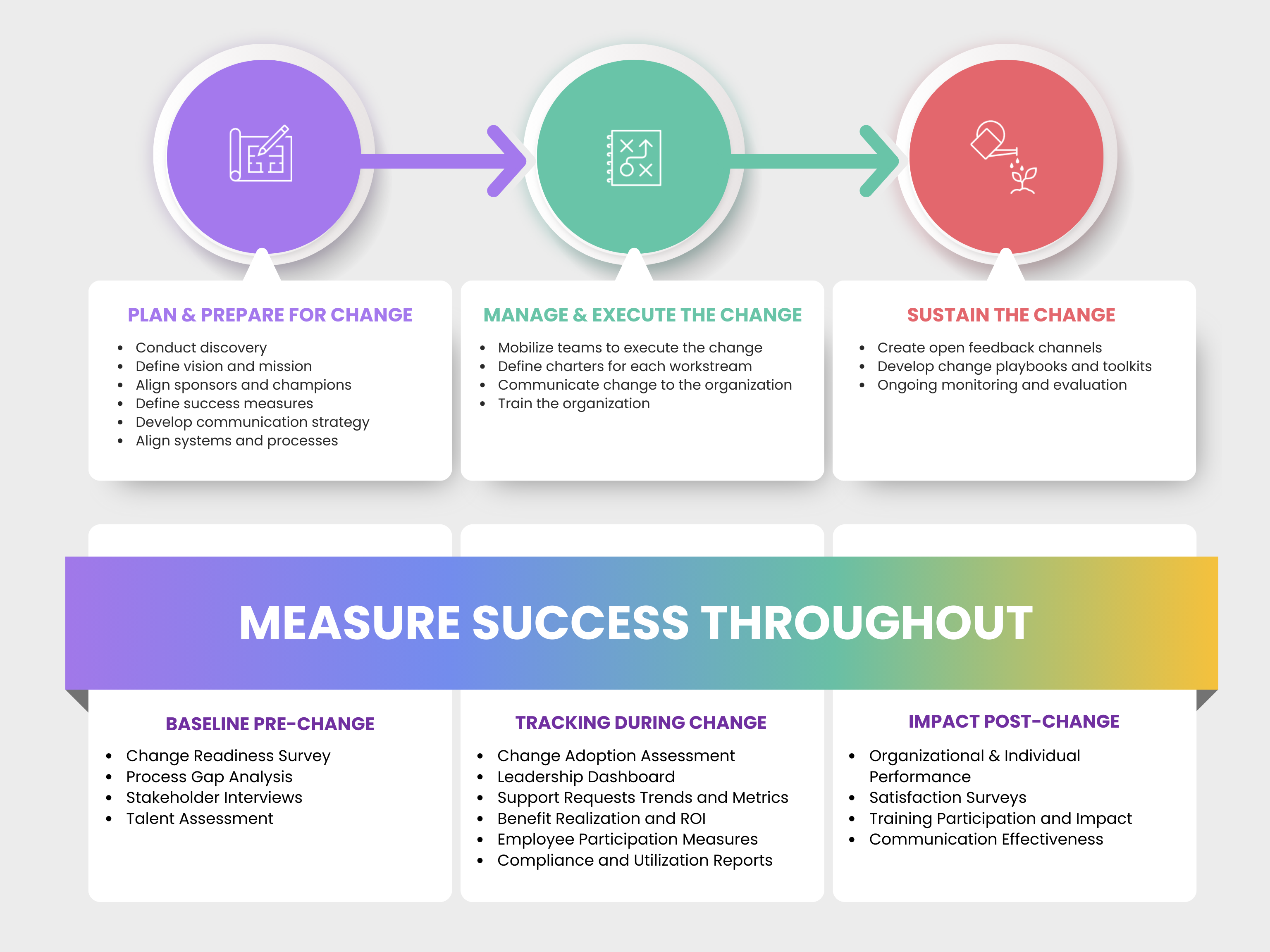Enabling Organizations To Empower and Value Their Talent
DF Analytics is your compass for driving positive change through Diversity, Equity, and Inclusion (DEI) strategies. Our data-driven approach empowers organizations to foster an inclusive culture, embrace diversity, and unlock a world of endless possibilities.
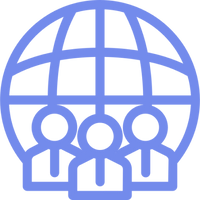 Diversity, Equity, and Inclusion (DEI)
Diversity, Equity, and Inclusion (DEI)
We believe that diversity, equity, and inclusion (DEI) are not just buzzwords; they are the pillars that shape a thriving and forward-thinking organization.
DF Analytics is dedicated to driving positive change and fostering an environment where every individual feels valued, empowered, and respected.


Laying the Foundation
Initial Exploration and Discovery
Deep-dive assessment of past DEI initiatives and existing DEI data and processes to assess achievements, probe for obstacles, and discover opportunities for measurable progress. Includes detailed written assessment as post-session deliverable.
Vision Lab
Leaders often have a variety of perspectives on DEI in the workplace and in society as a whole. This customized program combines inquiry, education, and facilitation to help leaders build a shared context and identify a shared vision for how they will create and embrace a DEI agenda to strengthen their organization.
Alignment Lab
Once executives are united behind a compelling DEI vision, the next step is to build alignment and ownership with influential stakeholders at all levels. In the context of widely differing perspectives on history and identity, discussion and action around DEI issues requires thoughtful, sensitive engagement. This customized program explores reservations and builds shared motivation, capacity, and alignment for DEI.
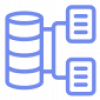
Data Services
Financial Impact Analysis
Financial Impact Analysis: Build the business case for human capital and DEI investments by quantifying the contribution of investments in human capital, including workforce diversity, to profitability and other financial metrics.
Accountability Audit and Benchmarking
Benchmark metrics of human capital and DEI performance against competitors, with options to drill down by race/ethnicity, gender, job classification, region (down to county), education level, and professional experience.
Culture Snapshot
Focused, one-off surveys to assess individual issues such as employee engagement, training needs, skillset gaps, flight risks, talent pipeline needs, employee value proposition, work/life integration, and hybrid work environment.
Digital Focus Groups
In addition to traditional focus groups (both remote and in-person), we also provide the experience of interactive, digital conversations (and so on with the existing text). Interactive, digital conversations that combat survey fatigue by gathering data from up to 1,000 people within 20-30 minutes. Net impact is faster time to insight and drastically lower administrative burden in data collection and analysis.
Culture Assessment
Comprehensive evaluation of insights across surveys, focus groups, and/or interviews to establish a baseline for strategic planning, training, executive coaching, and other culture change initiatives.
Training Impact Assessment
Baseline assessment of skillsets through surveys, interviews, and/or focus groups conducted before and/or after a training or intervention to assess measurable impact on mindset and behavior.
Longitudinal Employee Lifecycle Assessment
Holistic look at insights across recruiting metrics, engagement surveys, and performance reviews, including benchmarking.
DEI Annual Report or Progress Report
Use our proprietary framework for sustainable DEI progress to curate and design public-facing DEI reports for consumption to a broad audience. Includes research and review of past reports from the organization and a broad swath of its peers, design of a comprehensive reporting strategy, revision and review to integrate input from all key stakeholders and tell the story of successes and opportunities across the organization.
Process Audit
Analysis of institutional biases within processes, policies, and procedures. These analyses span the areas of compensation (especially pay equity and bonus structures), recruiting, development, promotion, and succession planning.
External Assessment
Identify unrealized opportunities by evaluating customer impact (gaps between desired and current market share) as well as corporate and social responsibility (brand equity, reputation, and approachability).
Compensation, Benefits, and Total Rewards / Benefits Program Design
Best-in-class program design based on internal and external research to optimize investments and maximize employee experience and organizational ROI. Includes data-driven, flexible program design and work with benefits brokers to chart a path to market for additional offerings.
Salary Structure and Market Competitiveness
Align current salary structure to the competitive market by ensuring internal equity and external competitiveness, while computing the hard dollar cost of decreased productivity or increased attrition. Design best-fit vehicles to increase retention while maintaining alignment with the organizational structure and culture.
Pay Equity Analysis
Intersectional statistical analysis of the relationship between compensation and potential causes of bias (e.g., race/ethnicity, gender, disability, or veteran status), while isolating the impact of confounding variables (e.g., tenure, professional experience, role, function, level, or performance). Frequently paired with Materiality Impact Analysis to quantify the monetary benefits of closing gaps in pay.
Scorecards and Dashboards
Build dashboards and scorecards by aggregating passive and active data from disparate systems and using 70+ proprietary metrics to reveal otherwise invisible biased behaviors that reinforce the exclusion of talented Underrepresented Groups (URGs) in the workplace. Available for both employee and executive audiences in either static form (scorecards) or customized, dynamic reporting that pulls data on demand (dashboards).
Software Solution Selection and Implementation
Advise and support the process to select and implement software solutions, including ATS, HRIS, or HR/DEI Tech. Includes needs assessment, functional and technical requirements, vendor evaluation and selection, business case for internal decision-makers, and/or support for solution implementation and integration into organizational practices and procedures.
Internal Data Guidance Document
Document and align guidelines for data security, access, and permissions with best practices to protect sensitive employee data while providing transparency into DEI metrics for progress. Customized documents can be adapted for different leadership levels inside the organization.
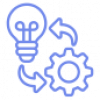
Implementation
Roadmap Creation
Once the vision and mission are in place and the employee sentiment baseline has been established, create leadership buy-in for the vision to ensure project success.
Strategy Development
Align employee feedback with business objectives to establish DEI priorities and success measures that are synchronized with key business drivers and organizational values.
Change Management
Assess the organization’s readiness for change and use the roadmap and strategy to define a communication plan. Provide training on best practice change management framework, including a change playbook and engagement strategy.
Project Management
Define operating mechanisms to deliver on the strategy, including governance, operational structures, project charter, and management operating model.
Monitoring and Evaluation
After the first phase of implementation, conduct post-mortem to assess whether actions taken to date are consistent with the initial roadmap and strategy. Diagnose and remove any obstacles and refine the go-forward path.

Leadership Trainings
Foundations of Diversity, Equity, and Inclusion
Comprehensive overview to build organizational capacity for the work of DEI by helping participants move from awareness to action and learn the concepts, language, and theory necessary to understand and participate in the work of DEI.
Inclusive Leadership
Examine participants’ current leadership style and explore a comprehensive new, inclusive leadership model. This includes best practices of inclusive leadership, sponsorship, and mentorship, including internal and external self-awareness, psychological safety, empathy, and an introduction to inclusive team development.
Combating Identity-Based Inequity in the Workplace
Deeper dive into specific forms of inequality and the requisite equity lenses necessary to address them, including Race Equity, Disability Equity, Gender and Sex Equity, and LGBTQ+ Equity. These trainings can be taken individually as well as a part of an ongoing series.
How to Have Difficult Conversations on DEI Topics
Understanding that the world is different from how we often perceive it to be requires shifting mindsets and developing skills to negotiate across difference. This workshop teaches skills on navigating high-risk DEI conversations in the workplace on a variety of topics.

Culture Change Trainings
Psychological Safety
Understand the core concepts of creating a psychologically safe workplace for all team members. Learn strategies to employ these concepts in alignment with personal values and leadership styles.
Effective Communication for the Workplace
Introduce the concept and skills of intergroup dialogue, with an emphasis on successful communication and conflict resolution across difference about challenging DEI topics.
Building an Inclusive Workplace Culture
Delve into the specific dynamics that get in the way of inclusivity, including the neuropsychology of implicit bias, microaggressions, and “covering,” and learn best practices to overcome these obstacles.
Unconscious Bias
Explore the 50 different types of Unconscious Bias and their social and professional impact. Engage in scenario-based training and role play to discover mitigation techniques to utilize in the workplace and personal environment.
Microaggression
Explore the types of microaggression and their impact on various protected and personal demographic characteristics. Learn techniques and strategies to reduce destructive behaviors, such as workplace bullying, harassment, or retaliation, and communicate more effectively across difference.
Cultural Competence
The increasing diversity of our global workforce makes it increasingly important to understand, communicate, and engage effectively with people from different cultures. Learn how to navigate the impact of cultural interactivity in creating trust and respect with customers and clients.
Allyship for the Workplace
Explore the concept of allyship in the workplace, including the role of allyship in creating an equitable and inclusive workplace, allyship assessment, best practices for workplace allyship, roles that allies play, and tools for effective allyship.
Understanding and Fostering Workplace Belonging
Understand what belonging in the workplace context looks like, particularly for members of underrepresented groups. Learn the language, concepts, and tools that enable successful participation in the creation of a culture of belonging.
Multicultural Marketing
If customers do not see themselves reflected in a marketing campaign, they will disengage from the brand. Learn how to compete in our increasingly diverse world by evolving marketing campaigns to specific underrepresented groups.
Solutions that Fit
Every Organization
As a leading data analytics, strategy, and training consultancy, we offer a comprehensive suite of services to meet all your needs under one roof.
Let’s Connect
At DF Analytics & Consulting, we are passionate about helping businesses thrive through our innovative, data-driven solutions for Diversity, Equity, and Inclusion (DEI). We understand the power of analytics and its potential to transform your organization’s approach to DEI, leading to sustainable and measurable improvements.
Don’t hesitate to reach out to our expert team to explore how we can work together to drive meaningful change within your organization. We’re eager to connect with you and discuss how our unique approach can unlock the full potential of your DEI initiatives.


